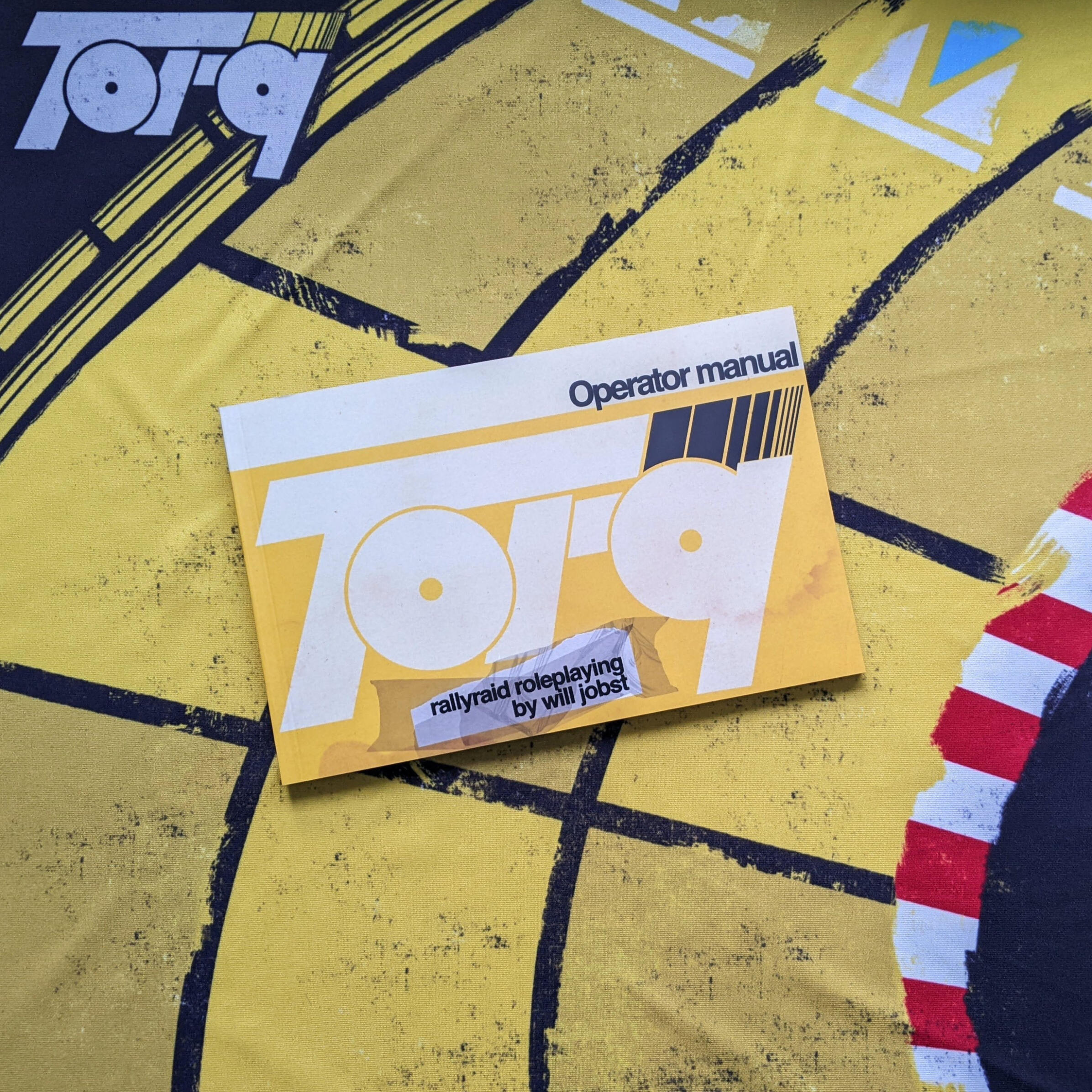
COMPACT EDITION
Welcome to the compact edition of TORQ! This site includes everything you need to get started playing.For the full, 100-page version of TORQ, check it out on itch.io or in physical on goodluckpress.co.
Getting Started
Race along the open road, collect the pieces of a changed world, and build something new together. You’re a driver, with a license to go anywhere and the grit to handle anything. There’s gas in the tank, an x on a map, and open road for miles. TORQ is a post-apocalyptic racing and roleplaying game for 2-5 players over the course of 1-3 hours, for single session or episodic play.
Two Games in OneTORQ is a mix between a board game and a roleplaying game. In TORQ, play is divided between the road and the reststop. The road is where drivers in their vehicles bash, crash, and thrash on the blacktop, played on a three-by-three grid where players move pieces and take actions against opponents. The reststop is where drivers rest and refuel, a place to unwind, explore, and learn about the world of TORQ. The road is a tactical challenge and the reststop is a free-flowing roleplaying area.How to Use This BookThis book is organized to walkthrough each step of play, starting with setting the tone and tenor of player interaction in your game, if any (called the rules of the road); making characters (called drivers), either randomly rolled or from a set of iconic characters (hard charging or scenic route); how to bash and crash on the road; how to refuel and relax at the reststop; and then a comprehensive collection of tools for generating content for your game of TORQ.
Items Needed to PlayPlay TORQ online or in person, with two to five players. There’s no game master, but someone should read through all of these rules to help guide the game. Before playing, make sure you have:
A shared space for everyone to play, digital or physical. If it’s digital, somewhere you can all share a screen and move things around.
Two six-sided dice per player
The road playmat (in digital or physical)
2-5 players, with one or more of those players in charge of the rules. There is no gamemaster in TORQ, but a player that’s comfy and familiar with the rules will make everything go smoothly
X-Card (by John Stavropoulos, found at http://tinyurl.com/xcard-rpg)
Printouts needed:
Character sheets
Road tickets
Enemy, obstacle, and event token
A print-and-play kit is available at willjobst.itch.io or goodluckpress.co with everything you need to bring this weird world to life with whatever materials you have. If playing digitally, check out the digital play kit, designed to be played on a shared digital whiteboard like Miro.
The World is Weird, Gone SourTORQ’s world exists after a global change. Is that a disaster, an apocalypse, a choice? Create and play vignettes of this weirded-world, a world where people and communities strike a truce with the hostile environment, surviving and thriving in the post-anthropocene. TORQ’s world is more humanistic than its post-apocalyptic predecessors: this is not a game for prepperpower fantasy, gun nut brinksmanship, or a rehash of feudalism. TORQ’s world is one of many communities living independently, tied together by the drivers who make it from point A to point B, mutual aid, and the weird world.Matchbox CarsThe TORQ playmat is compatible with matchbox cars. Consider using them (or any other representation) to bring life to your vehicles and drivers.
TORQ Preview: Rules of the RoadThis version of TORQ is all about getting this game to the table fast, burning rubber! In the complete version of TORQ, this section continues by describing the Rules of the Road, a way to calibrate how players engage with each other, and how others treat you at reststops.For the full version of TORQ, check out the digital at willjobst.itch.io or the physical edition at goodluckpress.co.Let's check out a preview of that section!
This world is unkind. Against that unkindness, a special agreement lives throughout every
hub of life: those with licenses are to be accepted, housed, and fed, in exchange for their skills and services. The road is filled with dangers, so drivers band together to make their journeys safer, especially if the wretches from the road attack. To be licensed is to adhere to the rules of the road.In TORQ, you determine the rules of the road before you start playing, or change them
up during the game. These determine how you, as players, act toward one another,
your enemies, and the communities you visit. Let’s look at three premade sets:Convoy
I can stop at any time, for any reason, without question.
I can veto any content or description in this game by using the X-Card.
I’m safe at the reststop.
I look out for and protect my fellow driver.
In communities, I’m welcomed. I can relax and refuel, and help however I can.
Rated PG. No guns. Our world is strange and apathetic.
This section continues to discuss two other sets of premade Rules of the Road, as well as several pages of guidence for making your own!
Making Drivers
Drivers go fast, stay alive, and rule the road. In TORQ, drivers are people with special abilities and skillsets that are in-demand in every community—doctors, librarians, couriers, botanists, and more. There are two ways to make drivers: hard charging or scenic route. Hard charging is for a group of weirdos that are here for a good time, not a long time. The scenic route is for a close knit group of (still) weirdos that band together to help wherever they can, lower and slower than hard charging.
Hard charging is for quick starts, where you want to get on the road as soon as possible. Hard charging is the arcade mode of TORQ. There’s a high degree of randomization—if you want a quirky group of weird and unbalanced drivers, hard charge it! Note: In hard charging mode, it takes two rolls to make a characters, one to determine horsepower (detailed later) and road actions, and a second roll to determine registration.The scenic route is for a more delicate character creation. This is a roster of iconic characters that you embody. If you want to spend time with a character that poses a challenge as a roleplayer, with relationships with other iconic characters, to play the “campaign mode” of TORQ, go for the scenic route.In the compact edition of TORQ, we'll just cover hard charging.
Character Sheet
The TORQ character sheet has the following pieces:
HP: In TORQ, you are your car. To that end, you and your car are represented by horsepower, or HP. HP is covered in detail on the following page.
Character/vehicle details: Driver details live here, including name, look, vehicle, registration, milestones, and upgrades. Registrations are each driver’s job they ply in communities. Milestones are optional goals used to buy upgrades.
Reststop: Here is where you’ll list checklist scenes (iconic moments at each reststop), activity (how drivers help), and sunset (what you do when this is all over).
Road actions: The road action zone is where your options are: move (how you get around), stunts (special abilities), and attacks (universal basic options for each character). The starting package is the unique advantage that scenic route drivers have–they change the way each driver interacts on the road.
Horn: For honking
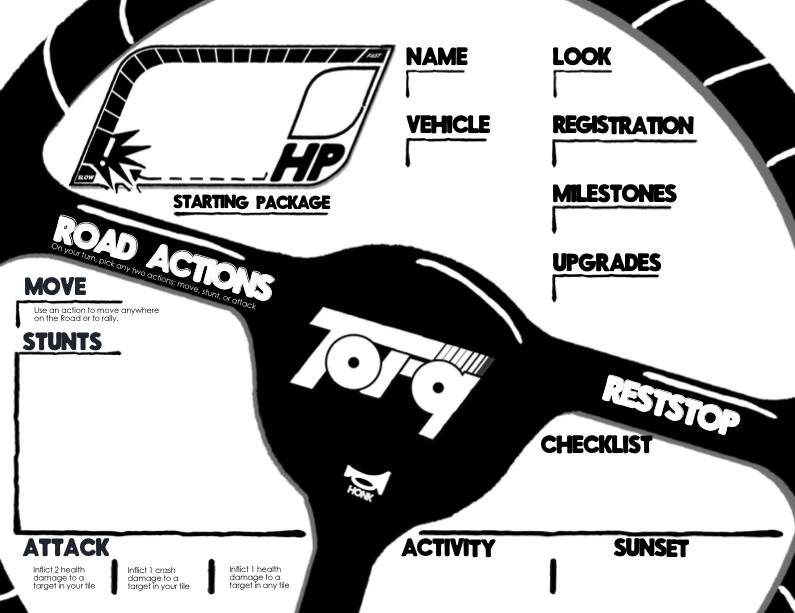
Horsepower
You are your car.In TORQ, your body and vehicle are resented by horsepower (HP). HP is made out of:
Health: how many hits can the driver(s) take, represented by pips •
Crashes: how many hits can your vehicle(s) take, represented by a bracket []
Speed: Your zero-to-sixty, a number from 2-12, with the lowest being fastest
This full expression (crashes, health, and zero-to-sixty) represents your driver’s HP.To generate HP, roll two six-sided dice and add them together. This raw number is your zero-to-sixty.
A roll of 3 and 4 is a 7, total, so our driver’s zero-to-sixty is 7.
YOU ARE YOUR CAR—likewise health is nested into crashes. One health in one crash looks like this . Every crash needs health in it, but multiple health can go into a crash. Spend points from the original result to build your driver. Health and crashes cost one point each.
Our driver chooses to spend four on health and three on crashes: •••• and [] [] []
Put health into crashes, and then write your zero-to-sixty afterwards. You can’t have any empty crashes or any unprotected health.
Our driver’s HP looks like this: [•][••][•]7
TORQ is concerned with how many times this character can crash, how much health they have, and how fast they are. HP is narratively flexible.It can represent two guys riding a motorcycle, a muscle car with a meanie name Drinks behind the wheel, a truck with a group of punks, or whatever you can come up with.
Reallocating HPDuring any reststop phase, drivers may reallocate HP to switch up the arrangement of health and crashes. Find a garage or some tools and describe how you’re changing your ride.
Hard Charging
Hard charging is TORQ’s arcade mode: here, roll two six-sided dice for your registration. Then, roll two six-sided dice to determine your HP, and then take the corresponding moves in the next section.If you want to spend some more time developing your drivers and their relationships to the world and each other, take the Scenic Route. It’s totally possible to play a hard charging game ofT ORQ with deep roleplaying elements—it’s just easier to set that up with the scenic route.
Hard Charging: Registration
To generate your reststop actions:
Roll two six-sided dice
Add results together and take the corresponding registration and activity
| Result | Description | Activity |
|---|---|---|
| 2-3 | Mytho: Skald, you bring and develop and collect the new sagas of this world. | At every reststop, add a local legend to your notebook. |
| 4 | Roadie: Every path a painting, you mark and track the ventricles of the world. | At every reststop, add an intersection to your scrapbook. |
| 5 | Perfumier: The aroma of the postanthropocene is yours to collect. | At every reststop, record a special scent. |
| 6 | Rebar: To build something permanent in this world of temporary promises. | At every reststop, sketch a unique bit of architecture in your notebook. |
| 7 | Journo: The people are the stories, you collect them census-like in your care. | At every reststop, add an interview to your notebook. |
| 8 | Loom: Connect the (literal) threads of community, these stitches tell a story. | At every reststop, add a new swatch to your collection. |
| 9 | Raindog: Weird weather is your game, chasing storms of any stripe. | At every reststop, record the unique weather in your notebook. |
| 10 | Snap: With your portable darkroom, you photograph the here and there. | At every reststop, capture a special moment for your photobook. |
| 11-12 | Lyric: There is an epic in the air, it’s yours to transcribe from static to stanza. | At every reststop, add a new stanza to your cantos. |
Hard-Charging: Road
Take your zero-to-sixty (the total of your HP roll) and cross reference it with this table to get your stock and custom moves. Drivers get both stock moves, but only one of their custom moves.To generate your road moves:
Roll two six-sided dice
Pick custom stunts
Determine HP
Take stock stunts
| Result | Description | Stock Stunts (take both) | Custom Stunts (pick one) |
|---|---|---|---|
| 2-3 | Experimental: This hypothetical "vehicle" defies a known law or two. | Inflict 2 health damage to any target, Launch everything in current tile | Heal 2 health on row, Ignore next crash, Swap with any tile |
| 4 | Turbo: They’ll eat your dust in this sleek machine. | Drag target in same tile, Lock any tile | Send any target to Rally, Reduce next damage to 1, Slow row |
| 5 | Nimble: Fast. Zippy. Responsive. | Pull target in any tile, Inflict 1 crash damage to any target | Place mine (2 health damage) on adjacent tile, Rebuild 1 crash to all targets in same tile, Inflict 1 health damage to row behind driver |
| 6 | Streamlined: A quick machine ready for some tough love. | Inflict 1 crash damage to target in adjacent tile, Push target in same tile | Place two [1/•] obstacles in Ahead, Targets in adjacent tile ignores next crash, Rebuild 1 crash to any target |
| 7 | Sturdy: Balanced between speed and stability. | Rebuild 1 crash to target in adjacent tile, Inflict 2 health any targets in same tile | Heal 1 health to targets in any tile, Cloak target in any tile, Slag target in any tile |
| 8 | Stubborn: You’re not going down without a fight. | Push target in adjacent tile, Launch everything in current tile | Heal 2 health on row, Ignore next crash, Swap with any tile |
| 9 | Fortified: This vehicle can take it and dish it back. | Heal column 1 health, Inflict 1 crash damage to adjacent tile | Slow any target, Launch any target, Lock current tile |
| 10 | Hulking: The road beast is hungry | Rebuild 1 crash to any tile, Inflict 1 health damage to current column | Place obstacle [1/•] on current row, Lure any target, Launch any target |
| 11-12 | Industrial: Car like a bunker. | Donate 1 health to any target, Inflict 1 health damage to current row | Double down current tile, Reduce two health damage column, Lure any target |
Now you’ve got the makings of a driver! Give them a name, and decide how they look (and their vehicle!).There are tables scattered throughout the book to give you some randomly generated vehicles, paintjobs, and more.
TORQ Preview: The Scenic RouteOn the scenic route, each character can only be chosen by one player—they’re one-of-a-kind drivers.Let’s take a look at each of the elements that make up scenic route drivers. Each driver has a starting package, stock stunts, a selection of custom stunts, a player-defined reststop activity, goals, rewards, and a sunset.A starting package is a unique advantage that this driver has. Stock and custom stunts are special abilities that this driver can use on the road. Drivers get both stock stunts, but can only choose one custom stunt.In the reststop section, the driver has a special activity that they do in each reststop. This is up to the player–how do you help those around you with your abilities?Scenic Route drivers have special goals, called checklist scenes. These are iconic moments that take place during their story. It’s up to the group to decide when, where, and how these happen.For every two checklist scenes, you get a reward! Rewards include a community-wide event the driver may put on, and a private event between drivers.Every driver has a last ride. In TORQ, that’s the sunset. Players who have both rewards can choose to sunset their drivers, retiring them.For the full version of TORQ, check out the digital at willjobst.itch.io or the physical edition at goodluckpress.co.Let's check out a preview of that section!
ModemFeedbringer, you connect communities to a ragged meshnet where people across this wounded world can link up. You’re a modem, you carry the connection and at every reststop you stitch together the world, if just for a moment.Road Actions
Starting package: Groupchat
At the end of every round, give any driver one health.Stock (take both):
Jailbreak: Lock or lure one target
Incognito: Cloak selfCustom (pick one):
Timeout: Send any target to Rally
Hotspot: Slag any tile
Buffering: Drag any columnReststop RegistrationActivity: What's something you do to help, everywhere you go?Checklist scenes:
Collect, digitize, and memorialize a late artist’s work
Connect a recluse to their friends, and join them for their monthly online meeting
Trace the signal of an anonymous online bully
Repair a surely-destroyed hard drive and return its memories to the communityRewards:
Host an online gaming festival for the community, bolstering spirits
Bring together the drivers and set up dating/friendship profiles for everyoneSunset:
And when you’ve completed all of them, find somewhere cozy and start that podcast you’ve been thinking about.
This section continues four other one-of-a-kind classes.
Rules: The Road
The road is a three-by-three grid represents a pack of cars burning down the road. The road is a relational space that keeps up with the vehicles.
The road is an abstract map that represents a pack of cars on the highway. The Road moves from top to bottom, with the top representing the future path of the vehicles and the bottom the past.
The road has three parts:
Road: the three-by-three grid where drivers duke it out among enemies, events, and obstacles
Rally: bottom area where drivers can tap out to regain health or crashes.
Ahead: top area where we see what’s coming next.
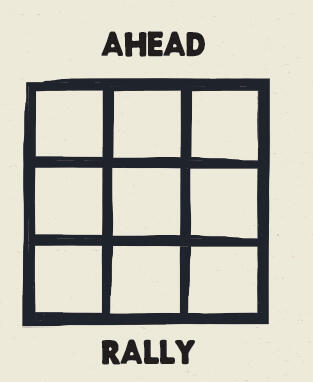
The TORQ playmat is a stylized version of this grid, but you may use whatever three-by-three grid you prefer. If you're playing in person, make sure that each tile within the grid is roughly three inches by 5 inches.
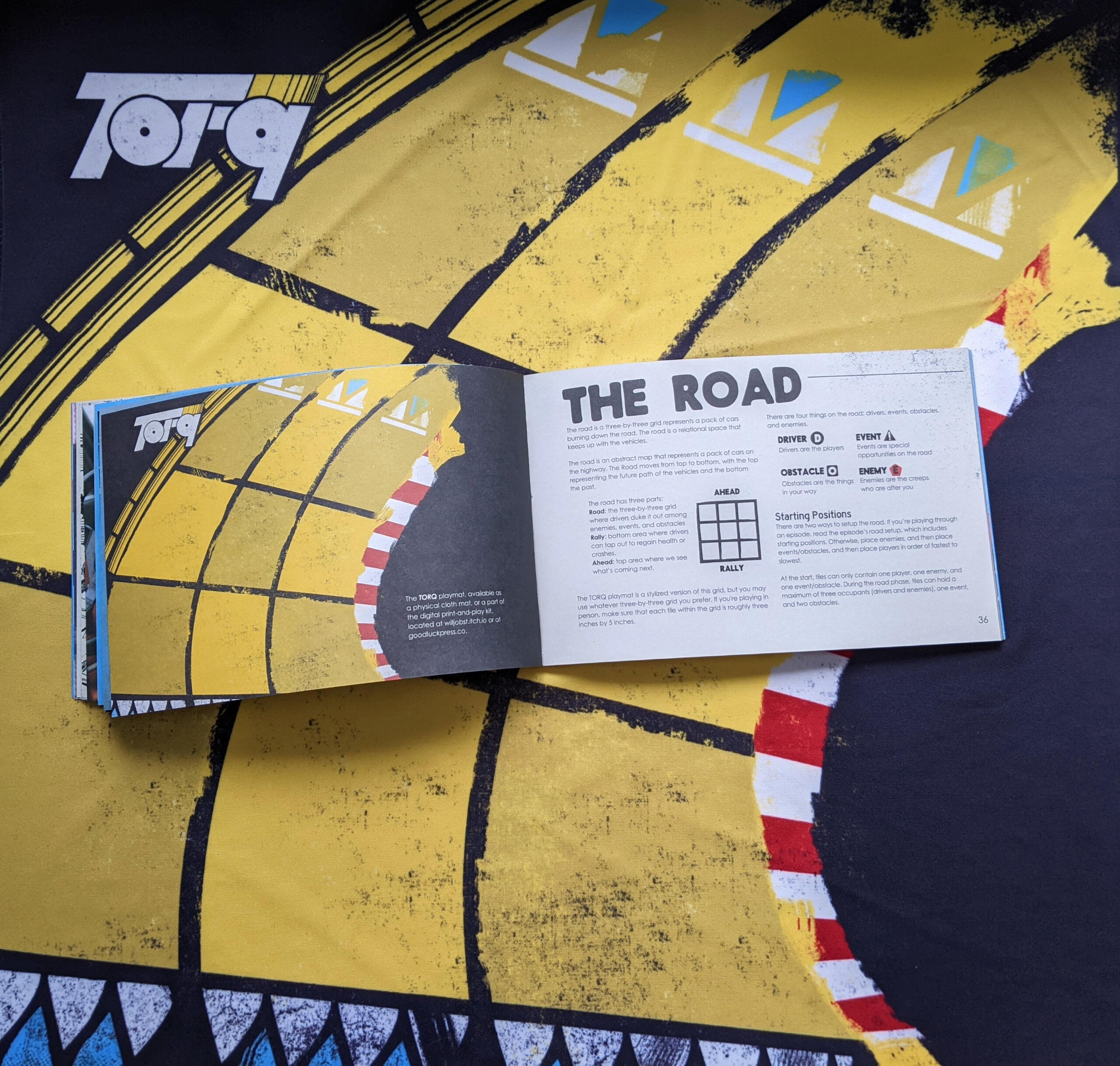
Overview
There are four things on the road: drivers, events, obstacles, and enemies:
Drivers are the players
Events are special opportunities on the road
Obstacles are the things in your way
Enemies are the creeps who are after you
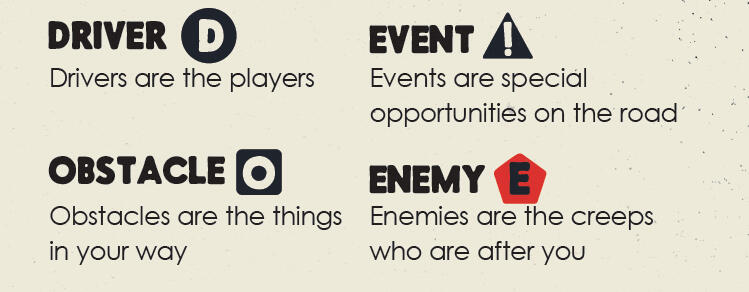
Starting Positions
There are two ways to setup the road. If you’re playing through an episode, read the episode’s road setup, which includes starting positions. Otherwise, place enemies, and then place events/obstacles, and then place players in order of fastest to slowest.At the start, tiles can only contain one player, one enemy, and one event/obstacle. During the road phase, tiles can hold a maximum of three occupants (drivers and enemies), one event, and two obstacles.
Rounds and Turns
The road phase is structured into turns and rounds. Each player and enemy gets a turn, as determined by zero-to-sixty order. The lowest zero-to-sixty goes first, and the highest goes last. In the event of a tie between enemies and drivers, the driver goes first. If drivers are tied, the one with the lowest current HP goes first.
Taking Action on the Road
On the road, drivers have two actions. Use actions to move, collide, attack, or perform a stunt. We’ll learn about those actions in the following pages. Enemies act within zero-to-sixty order alongside drivers. Enemies with the same zero-to-sixty act in tile order. Tile order begins with the top left tile, moving left-to-right, top to bottom.
TORQ AI
The road is powered by a simple AI that powers the enemies, obstacles, and events that make up TORQ. Players will have different responsibilities (the enemy director, obstacle director, and the event director), which are covered in detail later.
Round Procedure
Drivers and Enemies—Drivers and enemies act within zero-to-sixty order, lowest going first, highest going last.
Road Flow: Drivers and Enemies—All drivers and enemies that didn’t move shift backwards one tile. Resolve any collisions.
Road Flow: Obstacles and Events—All obstacles and events shift backwards one tile. Resolve any collisions.
Road Flow
When drivers and enemies have all acted, the road flows, pushing everything that didn’t use a move action backwards. Drivers and enemies that didn't use a move action is fall back one tile. All obstacles and events move back one tile.Flow can be used strategically to cause damage, avoid danger, and wreak havoc.Obstacle enters your tile: on your turn, pay the price or take the penalty.
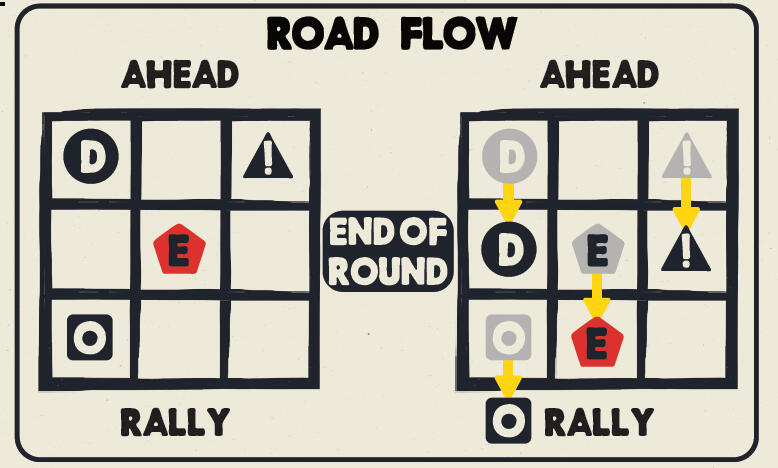
Flow can be used strategically to cause damage, avoid danger, and wreak havoc.Obstacle enters your tile: on your turn, pay the price or take the penalty.
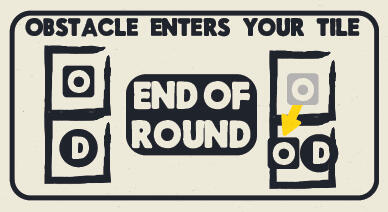
Obstacle enters enemy tile: enemy immediately takes the penalty.
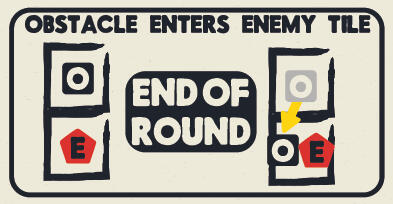
Event enters your tile: immediately choose to engage with the event and move it and yourself to rally, or to ignore.
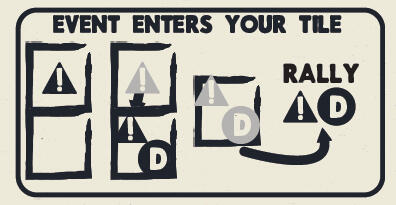
Enemy enters your tile: you both collide! See the next section for resolving collisions.
Collisions
If a driver enters a tile with an enemy, or an enemy enters a tile with a driver, they collide. When two things collide, compare active sets. An active set is the leftmost grouping of health inside a crash (the set to the left side). A collision may only wipe out one set at a time. The more sets you have, the more collisions you can take. Let’s take a look at what happens when two things collide on the road.
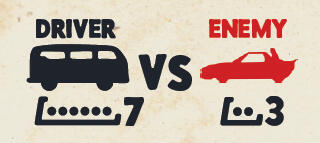
Driver has the same or more health: enemy loses a set, driver loses health equal to the enemy’s lost health.


Enemy has more health: Driver loses set and enemy loses health equal to the driver’s lost health.

Empty crash: An empty crash is when there isn’t any health in a set. Damage wipes out this crash before inflicting damage as normal.

Exposed health: this is when there’s no crashes in a set. Damage wipes out this health before inflicting damage as normal.

Moving
Use an action to move anywhere on the road or to rally. If you don’t move on your turn, move back one space at the end of the round. Let's look at some moving situations:
Empty tile: No penalty for moving into an empty tile.
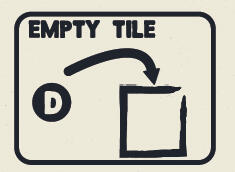
Tile with a driver or enemies: To move to a tile occupied by an enemy or a driver, choose whether to inflict a collision or not.
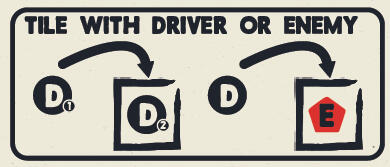
Tile with multiple occupants: To move into a tile occupied by multiple drivers, enemies, or a mix of both, automatically inflict a collision on everyone and only take the HP damage of one (of your choice).
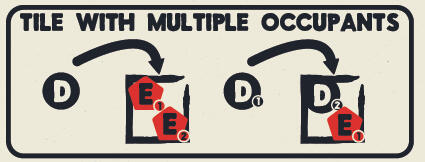
Tiles with obstacles: To move into a tile with an obstacle, pay the price or take the penalty.
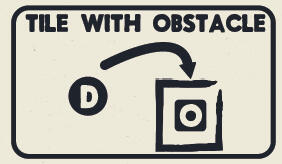
Tile with multiple obstacles: If the tile contains two obstacles, pay the price for both or take the penalty from both.
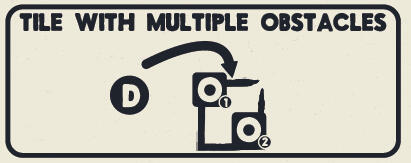
Tiles with events: To move into a tile with an event, choose whether to ignore the event or take your driver and the event into rally space.
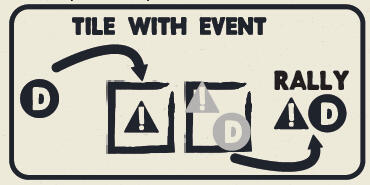
Tile with a mix of contents or “heavy traffic”: To move into a tile with heavy traffic, collide with all, but take damage from only one (of your choice), pay the price or take the penalty for all obstacles, and then immediately go to rally with the event.
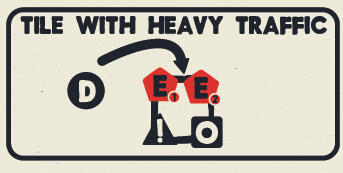
Healing
In TORQ, there are two ways to heal: by moving to rally to take a break from the action, or to muster yourself with the help of your teammates and Push It.
Rallying
To rally, spend an action to move to the rally area. Spend one action to regain two points of HP (crashes and/or health). You can spend as many turns as you want rallying, up until your full HP. When rallying, you cannot act, help other drivers Push It, achieve scenario milestones, or spend actions in any other way. To end the road phase before the required goals, all drivers must
be in rally.
Push It
When you run out of crashes, you can Push It. To Push It, ask your fellow players to donate one of their actions. If they don’t have any actions, they can donate an action from their next turn. For every action a player gives you, regain a lost set (crash with health). Players can bargain and strike deals for actions here. You can only Push It once per road phase, if you run out of crashes then, your car is totalled.
Out of Health, Out of Crashes
When reduced to either zero crashes or zero health, enemies and drivers cannot move, and may only take actions on the road, coasting along with the flow of the road until they reach rally. When enemies reach rally, they’re defeated. When drivers reach rally, they may spend actions on future turns to regain HP.
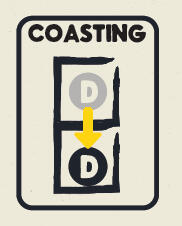
If drivers or enemies take any additional HP damage, reducing them to zero health and zero crashes, and they’ve already pushed it, the driver is totalled. If a driver or enemy is healed while coasting, they may take actions as normal.The road phase is a swingy and tactical game. Drivers have a few ways of bouncing back against overwhelming odds, including retreat! TORQ presents puzzles with no set solution, experiment and try things out!
Totalled
If you reach zero crashes and zero health, and you’ve already Pushed It, you’re totalled.Roll a six-sided dice for your vehicle and a six-sided dice for your driver. Three options are available for each, and three are yet to be discovered. Add additional Totalled options by spending a group milestone on an upgrade (as seen on page 66).Your ride is:
1. Salvageable, but stolen. The new driver’s name rhymes with yours.
2. On fire, it'll explode. Your fellow drivers can each grab one thing.
3. Fucked up. Left behind. A mechanic spends the rest of their life fixing it.
4. Reroll, or create this entry by spending advancements.
5. Reroll, or create this entry by spending advancements.
6. Reroll, or create this entry by spending advancements.Your self is:
1. Really dead.
2. You’re wounded, but you’ll drive again. Get in a backseat and pick it up later.
3. Done driving. Never throw good money after bad. You’re out of the game.
4. Reroll, or create this entry by spending advancements.
5. Reroll, or create this entry by spending advancements.
6. Reroll, or create this entry by spending advancements.
Stunts
Stunts are the signature maneuvers and tactics of drivers on the road. To perform a stunt, use an action and describe what your driver does. Whether you created a driver by hard charging or taking the scenic route, each driver has three unique stunts and three basic attacks. Stunts and attacks are expressed mechanically, this is to give you the opportunity to flavor their stunts however you want.
Basic Stunts
Collide: trigger a collision
Damage: deal health or crash damage to target
Heal: add health to target
Rebuild: add a crash to target
Shifting Stunts
Drag: during your move action, bring target with you, incurring additional collisions
Launch: move target to another non-adjacent tile
Pull: move target one tile closer to your current tile
Push: move target to an adjacent tile, away from your current tile
Swap: trade locations with target
Effects Stunts
Cloak: target cannot be targeted by others not inside its tile until the end Lock: hold target in current tile until the end of their next turn
Lure: target’s next action must be to move toward your tile
Slag: target takes double damage from every source until the end of their next turn
Slow: target cannot use a move action until the end of their next turn
Interference Stunts
Ignore: the next action taken against target doesn’t make an effect
Place mine: create a mine
Place obstacle: create an obstacle
Reduce: target subtracts incoming damage by a set value until the end of their next turn
Send: move target to specified location
Weird Stunts
Corrode: inflict crash damage to target at the end of each round
Donate: give HP (health or crashes) to target
Double down: target inflicts twice as much damage, but all damage inflicted against target from any source is doubled
Steal: take HP (health or crashes) from target
Crashing into Walls
If a road action pushes a target against a wall, or the boundary on the left or right of the 3x3 grid of the road, it’s called a wallcrash. Wallcrashes apply slow to the target, meaning they cannot move during the current round. If a target is wallcrashed twice in a round, they go immediately to rally.
Attacks
All players have access to attacks: personalized methods of taking down others on the road. These attacks are listed by their mechanical effects. In TORQ, to use an attack, describe what part of your vehicle, self, or kit is assisting you in this action. Take freely from your character, background, or any detail rolled on the tables throughout this book. The three attacks are:
Inflict 1 crash damage to a target in your tile
Inflict 2 health damage to a target in your tile
Inflict 1 health damage to a target in any tile
Enemies, Obstacles, and Events
While drivers are each managed by their players, the other elements of the road are shared among everyone: the enemies, obstacles, and events. Everyone will contribute to the story of the road by describing the details of their particular roles. There are three roles:
Enemy Director: Portrays the enemies, their actions and behaviors, and describes their actions with flavor.
Obstacle Director: Moves the obstacles along with the flow of the road, follows through with their consequences, describes their look and feel with flavor.
Event Director: Portrays the one-off special moments on the road, describes their elements and costs, and describes their circumstances with flavor.
Encounter Ticket
On the road, encounters are handled through the encounter ticket. This tool lets us quickly visualize and note the actions, enemies, and actions on the road, so we can get the game going quickly and easily.Encounter tickets and all other print-outs can be found at willjobst.itch.io or goodluckpress.co.An encounter ticket has the following parts:
Road situation text
Obstacles
Enemies
Events
Milestones
Tracking
Enemies
Enemies are who the drivers go against every time they get on the road. The can be people, things, beasts, aliens, concepts—if it’s on the road looking for a fight, the drivers will find it.
Enemy AI
Enemies in TORQ use a simple system to determine action. Enemy order is determined by zero-to-sixty order. In the event of a tie between enemies and drivers, drivers go first. Enemies on the top left tile acts first, from left to right, top to bottom, until the last tile (bottom right).
Targeting
Enemies target drivers with the following priorities:
Closest driver (adjacent or diagonally)
Slowest driver (highest zero-to-sixty)
Lowest current HP driver
Enemies go for near, slow, and weak targets.
Enemy Movement
Enemies can only move to one adjacent or diagonal tile at a time.
Enemy HP
Enemies have HP, like drivers. HP is read from left to right, with the zero-to-sixty after. When an enemy is reduced to zero HP, remove it from the grid.
Enemies at 0 HP
When an enemy is reduced to zero crashes, but still has health, or zero health but still has a crash, they begin to coast. Like coasting drivers, move coasting enemies towards rally with the flow of the road. Their vehicle has broken down, or the driver is incapacitated.
Enemies in Rally
Unlike drivers, enemies can’t heal in rally. When enemies at 0 HP reach rally, they are removed from play. When an enemy with at least a set (one health and one crash) goes to rally, place them in a random tile in ahead.
Enemy: Big Dozer
Enemies are built out of a few elements: a name, HP, description, and actions. Here’s an example:
Name: Big Dozer
Horsepower: [••][•••][••]11
Description: Frankensteinian construction equipment
Number of actions per turn: One action per turn
Action(s): Shover – Move into a random tile with a driver and collide
Representing the Road
TORQ is a flexible game, likewise, it can be represented at the table in many ways. Drivers, enemies, obstacles, and events can be represented by notecards, sticky notes, matchbox cars, carefully painted minis, or whatever you have lying around. In practice, having HP visible on the playspace makes the game run smoothest. Experiment with what works best for your game!
Obstacles
Obstacles are the things in your way. Each obstacle has a name, price, and penalty. If a player shares a space with an obstacle, they must pay the price or take the penalty. If an enemy shares a space with an obstacle, they always take the penalty.When an obstacle enters your tile, on your next turn you must pay the price or take the penalty. Whenever you enter a tile with an obstacle, you must immediately pay the price and penalty.Obstacles move with the flow of the road. Every turn, after every player and enemy has acted, move all obstacles towards rally by one tile.Obstacles are notated with the title of the obstacle and then the price (in the number of actions) and the penalty in parenthesis. For example: Tight Fit (1/1•), the price is one action with the pip representing one health damage.Obstacles can be represented by tokens, terrain, drawings, or whatever you have available. Some driver and enemy ability allow the creation of obstacles.
Mines
Mines are similar to obstacles, they’re objects that are placed on the board that move along with the flow of play, but they can be activated whenever the owner wants. If a player or enemy shares a space with a mine that’s being detonated, they take damage.Mine is an abstract term, it could be as obvious as a depth charge style mine, or it could be a passenger who detached their sidecar to ambush an opponent.
Obstacle Example
For example, when driving through a narrow pass, the drivers encounter obstacles like tight spaces and debris. They are notated like this:
Tight Fit (1/1•): If a driver is in a tile with this obstacle, they must spend one action to avoid taking the penalty of one health.
Debris (1/[1]): If a driver shares a tile with this obstacle, they must spend one action to avoid taking the penalty of one crash.
Events
Events are unique road moments. To start an event, move to the space with the event and immediately move yourself and the event to rally. At the end of the round, resolve the event.Events are one-of-a-kind road moments that might feed into a larger storyline, be a one-and-done moment on the road, or something else! These are dynamic, they might include costs, benefits, new characters, new dangers, or signal future events. Events take one or more turns to complete.Some events have discrete rewards (often as part of an episode). Others have a reward in the form of an milestone. Each event gives an opportunity to engage deeper with the world, to begin a quest during your episode of TORQ, or to provide a third place away from the reststop and the road.Events appear on the road as tiles— drivers can choose to stop there in the middle of the action, taking them out of the combat, but first in-line for the event. Or, drivers can use an ability to lock the event in place, or double back and try and search for it. If the event is mapped out by the drivers, they can return at any time. If trying to return via memory, drivers will have a harder time. The road shifts and changes, but not nearly as much as its contents. Hopefully it’s still there!
Backtrack
To backtrack to an event, everyone who wants to go back calls two numbers between 2 and 12. One player rolls two six-sided dice and adds the results. Everyone who called the correct number finds the location and can engage in the event. Everyone else eats their dust.
Here’s an example event: Mountain MemoryTrigger: second round and every other round after that. Place this event on a random tile with an obstacle in it.
Reward: Tell the mountain your name and record yourself in its memory. Do not go to rally. Move every obstacle to a random tile.Bonus:
+Pay one health, as above but go to rally. Embed a piece of the path within your chassis.
+Pay one crash, as above but do not shuffle obstacles. Memorize the name of one who has passed before.
+Pay one set, as above but do not shuffle obstacles and lock all obstacles. Speak with the mountain, answer one of its questions.
Milestones
Milestones are ways for drivers in TORQ to measure themselves. Milestones are personal, and sometimes at odds with the goals of the drivers as a whole. Some games of TORQ are filled with this milestone-driven player-versus-player, and others have it as a single element of a larger palette. The more milestones, the more inter-player conflict might arise.Milestones come in three types, small, big, and group. The small and big milestones are personal to each driver. The small milestone is something that takes one or two road phases to complete, and a big milestone takes more. The group milestone is something that the group of drivers are working towards, and might take several sessions. A group milestone can’t be randomly generated, it has to be something that guides the episodes of gameplay.For a milestone generator and how to trade milestones for upgrades, see page 65.Small
Get your hands on a tapedeck
It’s time for a paint job
Jump over another car 3 times
Big
Spend three dice on avoiding damage from obstacles
Destroy four enemies by knocking them together
Drag another vehicle to rally
Group
Cross the Odessa road
Collect the refrigeration materials needed to fix the reefer truck
Get stranded in the dead center of a desert and see who will pick you up
End of the Road
The road phase is complete when the objective is met, all the drivers are in rally, or all the enemies and obstacles are overcome. When the road ends, play transitions from the road to the reststop. Each player that handled a director position (enemies, obstacles, or events) describes how those elements recede in the rearview. Then, each driver narrates how they make their way to the reststop. This can be via a CV radio chat between drivers, taking a pitstop to cool down, blow off some steam, or, dangerously, sleep.After that, it’s time for a reststop.
Here’s an example encounter ticket: Here’s a sample encounter ticket, where the drivers face off against a pack of smartcars. For tools to build encounter tickets, see TORQ, page 67.
SituationJailbroken: Passing close to the signal coverage zone of a rogue factory, descended on by a pack of networked, self-driving vehicles.Objective: destroy the enemies.
Placement:
Signal Booster: one in first row (randomly). Refresh once
eCar: one per driver, plus 3 placed randomly. Refresh two.
ObstaclesSheets of Drones: add a Bad Visibility (Drones) obstacle to every tile in the first row. Refresh when off grid.Bad Visibility, Drones (0/0: while in tile, cloaked)
EventsTrigger: Signal Booster is totalled (first time). Event placed on their last tile. Pay one dice, get: The signal platform cracks with activity. You approach and trigger proximity protocol: Scatter obstacle to random tiles.
+Pay one crash, get: Nanobot RollCage: rebuild all lost crashes.
+Pay one health: take strange device from the vehicle to investigate at the Reststop
EnemiesSignal Booster, HP: [•••] 6
A web of transistors, this mobile hotspot connects to everything within range. One action per turn:
Rally cry: Heal fellow enemy 2 health
Segue: Move away from danger
eCar, HP: [••••] 6
Selfdriving futuristic vehicle, wires and components grafted on as if by random. One action per turn:
Seek and collide: Get into tile with nearest driver and collide
Milestones: End a turn with every driver in rally. Don’t get hit. Launch an
enemy into another.
Rules: The Reststop
At the end of every road is a reststop. A place to rest and refuel, communities to explore, the low and slow moments away from the fury of the road. At a reststop, players inhabit their driver in a communal space wherever the cars have stopped. Players may also choose to embody the residents of the community, more abstract concepts like the weather, the enemies waiting on the road, or holidays and community events in the reststop. By default, this space is safe from dangers. Drivers fix their vehicles, speak to locals, and interact with each other.The reststop is populated with the options available to the players. This portion is “open-world”—there are points of interest, people to talk to, locations to explore, and activities to complete.
Reststop Procedure
1.Roll up
Take a look at the reststop, clock its vibe, and discover its bargain.
2.Park
Each player rolls 2d6 and places it on the reststop to represent a point of interest.
3.R&R
Ply your trade, partake in activities, explore places and relationships. Embody characters, create scenes, and see how the bargain interacts with daily life.
4.Roll out
When finished, heal up, determine your next location, and leave.
Roll up
At the end of the road phase, you near the next reststop. Remove all the pieces from the road. If you’re playing in a physical space, use a blank piece of paper to represent your reststop. If you’re playing in a digital space, generate a blank board that players can write on. We want a clear space to write things down, share pictures, make drawings, and more.If using a premade reststop, read the roll up text aloud. If making your own, choose a vibe palette and work as a group to give this place a unique feeling and circumstance (page 86).
Park
Here is where we fill the reststop with people and places. We create a hub of activity, with people and places. These points-of-interest (POIs) represent where we can talk to people, explore locations, and build stories.Everyone rolls two six-sided dice and places them on the reststop.Assemble the dice on the reststop to represent different locations. Name locations, add any locations or people aswanted by the group.One dice represents the type of location, and the other dice represents the person or event located there. Dice can be isolated, for abandoned buildings or wandering people. Dice can be pooled together to create linked locations and people.If it’s a small community, everyone should roll just once to create the reststop. If it should be bigger, or you want more action, whatever the reason, roll more dice. This can be during or after the Park phase. Places grow larger the more we focus on them.
Rest & Refuel
Once we’ve populated the reststop, it’s time to rest and refuel. This freeform character and location exploration is the bulk of the reststop phase.There are four things to do at reststops:
Investigate strand
Registration activity and checklist scenes
Reallocate HP
Upgrade vehicle (see page 66)
Players may choose multiple activities. Players can opt out of any activities. Additionally, use this time to take a short break from the game.Want to do something in the reststop that’s not covered by the strands or registration activities? Chat with the group, if there’s a consensus, go ahead!
Investigate Strand
Pick a dice on the reststop and sketch out a scene with the other players. Who’s involved? What’s happening? How does it happen? Once the scene is sketched, decide among the players embodies plays what—players can inhabit their driver, non-player characters in the community, or setting elements like the community itself, the weirdness of the world, the weather, and more.When approaching a strand, chat about the expectations of the scene. Once you have a sketch of the scene, play it out with your fellow players, or narrate the results. Once the scene has been resolved, ask these two questions:
Is this strand complete? If so, remove the dice from the board.
Do we want to see where this strand goes? If yes, and someone has an idea, roll the dice on the reststop to make another strand, this time related to the first. If no, take the dice off the board. Maybe this strand will appear again!
If the rest of this story can be resolved at this reststop, play out scenes and moments until it is. If it goes beyond this reststop, make it a goal and go out on the road and live in that story.
Registration Activity
This is what you do, you’re a driver to ply your trade. At each reststop, each driver should ply their trade by narrating a scene using their registration activity. It’s up to the driver whether or not they want to include any other characters or players.Each reststop will turn into a mosaic of strands, registration activities, low-key roleplay, character and location exploration. There is no wrong way to do this, a reststop could be a quick refill before getting back to the action, or it can be a few weeks to truly unwind.
Reallocating HP
During any reststop phase, drivers may reallocate HP to switch up the arrangement of health and crashes. Find a garage or some tools and describe how you’re changing your ride.
Roll out
When you’re finished, choose to stop play, or to hit the road again. Before jumping to the road phase, take a break in real life. Before hitting the road, heal back your HP. This cycle of road and reststop is what TORQ is all about! In the following pages are tools to generate content for you game, like an encounter ticket generators, rare gear, option challenges, and more. For an introductory episode of TORQ to play, check out HALF-HARDCORE, available for free at willjobst.itch.io.
Episode 1: HALF-HARDCORE
IntroductionThere’s a mountain pass called the Odessa Road. For a three day period, it’s open for anyone to make it to whatever lies out West. You should know, drivers that try the pass don’t come back. It’s not just the terrain that’s a problem.Everyone with wheels and a bad conscience are all cruising for the same window.
Sidebar: Half Hardcore is an intro episode for TORQ. In it, players make a fresh group of drivers as they venture into the unknown, into a new area in which they might continue on a campaign. If this is your first experience with TORQ, take is low and slow, learn the quirks of this game and the road, and relax and refuel at reststops. Elements of this game are introduced section-by-section, so you can learn as you go. Each road segment will feature progressively more content, until you hit the first “full” experience at the end. It will start with just enemies, a phase with just obstacles and events, and a phase with everything—and a boss!Make sure to choose the rules of the road for this session. The rules of the road are a special agreement between drivers that serve as a social contract and a rules of engagement. For a first-time experience, try playing with the Convoy rules of the road:
I can stop at any time, for any reason, without question.
I can veto any content or description in this game by using the X-Card (by John Stavropoulos, found at http://tinyurl.com/x-card-rpg)
I’m safe at the reststop.
I look out for and protect my fellow driver.
In communities, I’m welcomed. I can relax and refuel, and help however I can.
Rated PG. No guns. Our world is strange and apathetic.
Rules of the road can be customized to your liking, as covered on page 3 of TORQ: Operator Manual.
Hitching point
Radio signal cuts through. To each of you, whether you’re were blowing through on the way to a shaky prospect or looking for the next thrill. Off the last gig and searching for the new one.The MC and their “calling-all-drivers”, voice half-canticle and half-hardcore.“Fresh starters, new leafers, hear this: the Odessa Toad is open. The hymn of over-the-mountain is calling. Will you answer?” A list of coordinates follows.This isn’t the first obvious trap you’ve driven into, but it’ll be the first you do so as a caravan. You’ve been baking in the desert for days now, at a reststop called Hatoff’s. Gas is gas, so you, assembled, are waiting for the guide to Odessa and unto the borderlands.Shout out to Stan Hatoff’s in Jamaica Plain, Massachussetts. I’ve seen more low-speed car collisions there than in GTA 5. Gas is gas!
Roll characters
It’s time to make characters: decide whether you want to hard charge it (all random everything), or the scenic route (a curated group of iconic characters). These begin on page 10 of TORQ: Operator Manual.Note: if you’ve got a big group, or players that want less commitment, consider sharing roles. Drivers can be a group of people in the same pickup truck, or motorcycle and sidecar, or tank and turret! During the reststop, everyone gets to participate in freeform roleplay.The days are long here, so you’ve shared a bit about yourselves. From the same community? Strangers bonded by a shared work?You’ve spent the remainder of your favors, money, or good luck getting what you need to get ready. Down Odessa way.
Road Phase 1: Heckheads
SituationHeckheads are problems on wheels. They’re opportunists, ambushing those moving from community to community. Right now, that’s you. Heckheads descend off the mountain and chase the drivers into the pass.The road is dusty blacktop with red clay adjacent. Mountains loom on the horizon and desert brush looks thorn enough to pierce your hull.Sidebar: Here we’ll learn how to drive, get enemies on the board, and collisions. Choose who’s going to be the enemy director (page 45, TORQ: Operator Manual). Obstacle and event directors won’t be needed until future road phases.Objective: destroy the enemies.
Placement:
One Heckhead per driver
Two Scags on random tiles
ObstaclesNone: this road phase is all about learning to drive, getting enemies on the board, and crashing around.
EventsNone.
EnemiesHeckheads
Roving gang of creeps. After your vehicle and its contents.
HP: [••] 5
One action per turn:
SEEK & COLLIDE: Get into tile with nearest driver and collide
Ability:
BACKUP: On total, queue two Scags
Scags
Long, low vehicles with a mean harpoon platform.
HP: [••][•] 7
Scags have one action per turn
SEEK & COLLIDE: Get into tile with nearest driver and collide
HARPOON: If no available tiles, lock adjacent driver
Milestones: End a turn with every driver in rally. Don’t get hit. Launch an
enemy into another.
Reststop: Basecamp
Basecamp sits in the shadow of the mountain, built into a rocky outcropping.Roll up
The first thing you notice is how small it looks in comparison, and the last thing realize is they’ve had telescopes on you for the last many miles.Park
This place has struck a bargain between their obligation to guard the Odessa road, and the slow-aging of everyone who lives here. There is dissent in their community, leading to the pirate signal of the road opening.R&R
Place two dice in the center, representing the Meeting Garden and the Roadminder. You’ll have to convince them to let you through. Roll remaining dice as normal.Roll out
With the mountain passage, it’s time to begin the dangerous agility leg of the run.
Road Phase 2: Reverberator
SituationAnd away they climb, vehicles sucking in the thin air, but there’s more to be worried about than the fall, it’s the way the mountain feels.Thin roads, hairpin turns, and sheer edges. The mountain’s memory will be the last test.
Here we’ll learn how to place and manipulate obstacles, including an event and milestones.Objective: every driver must visit a Mountain Memory tile.
ObstaclesHairpin descent: on the first round, add a row of (1/[1]) obstacles to the first row. Replenish obstacles when off the grid.Squeeze: every round add Rock wall (1/[1]) to random alternating left and right columns in the first row.
EventsMountain MemoryTrigger: second round and every other round after that. Place this event on a random tile with an obstacle in it.Tell the mountain your name and record yourself in its memory. Do not go to rally. Move every obstacle to a random tile.
Pay one health, as above but go to Rally. Embed a piece of the path within your chassis.
Pay one crash, as above but do not shuffle obstacles. Memorize the name of one who has passed before.
Pay one set, as above but do not shuffle obstacles and lock all obstacles. Speak with the mountain, answer one of its questions.
EnemiesNone
Milestones: don’t get hit, lie to the mountain.
Reststop 2: Middlemountain
Middlemountain is a community on the margins of what lies before and what lies after. This was a waystation, once. A prosperous reststop now a secret milemarker.We’re the first visitors here, from this side.Roll up
The first thing you notice is the lush green everywhere. This is a verdant forest within the mountain. The last thing you notice is how every door is propped open.Park
The bargain this place strikes is between the depth of these caverns and the recreation here. Beneath the canopy is a place for sports, ball games that utilize the sightless ceiling of this place, field games that spread over weeks.Each driver should decide which game is most interesting to them, and invent it.R&R
Place three dice on the reststop, away from each other. These represent the
Tinkerer working on a secret project. A half buried discovery. A community work project.Roll dice and create the hub of this place.Roll out
The final leg, out of the mountain and onto the open-skied Odessa road.
Road Phase 3: In the Shade of a Big Rock of Gold
SituationOn this side of the world, the mountain on your side is here, a manycolored golden sheet, heat distortion radiating from it, cause it to dance in the rearview.A vibration passes through the air, and pouncing from the hot ridge is a tight group of vehicles in formation.Sidebar: Here, we’ll put it all together. Obstacles, enemies, events, and a boss!Objective: total Karat twice.
Placement:
Flakegliders: one per driver, and 3 at random.
Karat: place on the second round.
Obstacles
Rocks of Gold: Every round, add a Gold Boulder (1/[1]) tile to the grid at a random tile. Start road phase with three randomly placed Gold Boulders.
EventsTrigger: Karat is totalled (first time). Event placed on their last tile.
The geode cracks open, hissing with smoke and boiling sludge.
Pay one health, get: move all obstacles to the location of your choice (must be on grid)
Pay one crash and two health, total all Flakegliders.
EnemiesFlakegliders
HP: [•][•] 5
Wheels, wings, and achugging engine spitting neon fog.
One action per turn
Move to tile with driver and launch into danger or another driver
Karat
[•••][••]7
A geode tumbling at speed, driver gyroscoped in the center.
Two actions per turn:
Mantle: give a fellow enemy Ignore this round
Exfil: Move out of danger.
Tecton ray: Pull all obstacles
Boss: refresh once after totalled, and add 3 more Flakegliders. When refreshed, give Karat a third action to use every turn:
Refract: inflict 2 •health damage on the lowest HP driver.
Milestones:
Small: don’t get hit, total an enemy with an obstacle
Big: total Karat once
Group: Scream down the Odessa road.
Your campaign of TORQ has just begun. Welcome to the Odessa road, dotted with communities, strange flora and fauna, and a weird world for you to create, discover, and tear through.This is episode 0 of ODESSA ROAD. To be continued…